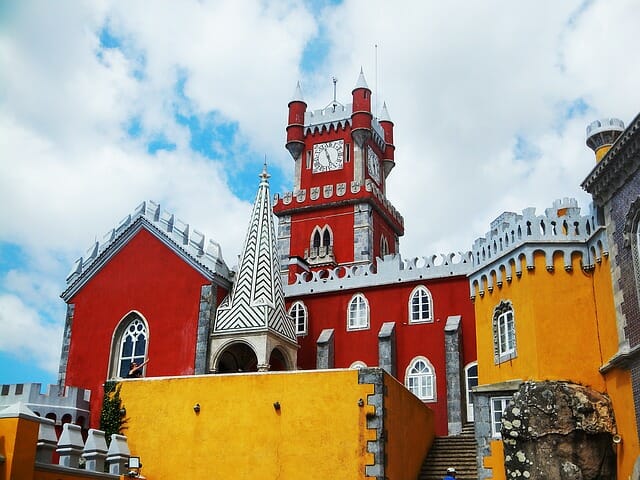Best Day Trips from Lisbon
Lisbon is definitely one of the best destinations in Europe, though sadly it is overshadowed on the global scale by Spanish rival cities such as Madrid. But nevertheless, this Portuguese wonder deserves a look-see from everyone stepping foot in this side of the world! You’ll surely be inspired by the best day trips from Lisbon.
To make your Lisbon trip even richer, though, you can always set aside time to step off the city bounds and discover more of what Portugal has to offer. Not only can you discover a wealth of stories and wonders from neighboring towns, it’s also an opportunity to reward yourself with views and experiences that are outside the mainstream!

Whether you’re looking for traces of the country’s history, or you’re gunning for the opulence of its royalty, there’s something for you. There’s even something for those who want a beach getaway in the middle of their European trip!
In this list, we have compiled several day trips from Lisbon that won’t take up much of your time or budget. Like this one from Sintra to Cascais!
Before you pack your bags and head to the nearest train station though, make sure to buy a Viva Viagem card first. This is a reusable public transport ticket that is used for all Lisbon travel. The initial purchase is just EUR 0.50, and it can be used for all rides. Let’s begin!

World Famous Sintra
A Sintra day trip from Lisbon is one of the most famous, for two good reasons — its proximity to the capital, and the wealth of sights and history the place has to offer. Do expect some crowds, but nothing that will spoil the experience.
Sintra Day Trip
There are two railway stations that connect Lisbon to Sintra. Both can be used to get to your destination. One departs from Lisbon’s Rossio station, and ends at Sintra station. The other one starts from Oriente station, and passes through other noteworthy stations as Areeiro, Entrecampos, and Sete Rios.
The most convenient is the Rossio-Sintra line, which starts near the Baxia district. If you’re travelling from Lisbon’s airport, however, the Oriente-Sintra is more accessible since this is also the main intercity station. Both routes cannot be pre-booked however, so starting your trip early is crucial.
As for the fare, it’s standard no matter which station you start from: EUR 2.25 for an adult and EUR 1.15 for a child. The return ticket is the same. Bus services are also available, though they take longer than trains. Plus, bus stations are further out of the way than train stations.
Helpful Travel Tips
While European getaways are usually characterized by a joy ride in a rented car, it isn’t advisable to drive to Sintra due to its narrow roads. This is doubly true during summer, when the hilly terrain is packed with an endless traffic jam.
Once you’re in Sintra, steer clear of the hawkers selling tourist services and walk to the town center instead — it only takes 15 minutes via the main road, and it’s a scenic and relaxing activity. If you’d like to sit back instead, a 434-tourist bus passes through the station. Of course, it’s most advisable to book a Sintra Tour instead — this takes care of even your transport.

Sintra Tour and Sights
The whole area is a historic spot recognized as a UNESCO World Heritage Cultural Landscape. Whether you’re looking at its rugged natural beauty or its ancient structures headlined by the 14th-century Palácio Nacional de Sintra, you’re in for a treat at every turn!
The castle, of course, is a must-see. This was once the summer home of Portugal royalty, with a good selection of rooms and halls. If you want something even more ancient, the Castelo dos Mouros is just a short shuttle ride away. Walking its ancient pathways will lead you to a magnificent vista of the Serra de Sintra mountains.
And you’d best not just look at these mountains — the Serra is home to the Palácio da Pena, arguably Sintra’s greatest treasure. While you can take the town bus up to here, nature lovers are better off enjoying the lush (though steep) trail that leads up to the 19th-century structure. The Palácio da Pena is a lavish display of royal riches, calling to mind fairy tales of old. Another great spot, the Monserrate, can be easily reached from here via the shuttle bus — here you’ll see one of the most beautiful gardens this side of Portugal.
Cascais: Coastal Paradise
If nature and old structures isn’t your bet, perhaps one of Portugal’s most picturesque coastal towns would be a better fit. Cascais is not just a great destination, it’s a great journey as well. Most of the 25 kilometers going here will be tracing the country’s coastline.
Getting to Cascais
Cascais is connected to Lisbon by another urban railway line, the (aptly-named) Linha de Cascais. It is a direct service, which adds to the convenience of the trip. The line runs along the north side of the Tejo Estuary, which makes it a scenic ride — especially since the train will pass through some of the best beaches in the area. From Lisbon, head to the Cais do Sodre station at the center of town, and alight at the Cascais station.

The train fare is EUR 2.25 for adults and EUR 1.15 for children, via the Viva Viagem card. If the ticket stations are crowded (as they usually are), you can use one of the ticket machines in the area. The journey takes around 40 minutes, and trains depart every 20 minutes. This makes it one of the
Just as with Sintra, the train line is preferred to bus lines because of the better location of the Cais do Sodre station compared to the Lisbon bus terminals. While roads are easy to navigate here, parking may be a problem for those driving their car, especially during summer.
Cascais Sightseeing
Cascais isn’t your typical sleepy fishing town. It has a noble past, when the 19th-century king ordered his summer home to be moved to Palácio da Cidadela de Cascais. This castle is a waterfront fortress, the first in a series of grand structures (especially mansions) that followed the king. The well-manicured citadel is now a hotel, open to the public!
Today, it’s a beautiful thing to see these structures mingling with the more humble abodes of fishermen and townsfolk. You can also peruse the narrow alleyways leading from the waters, letting yourself discover new nooks and crannies. There are parks, museums, and other historical landmarks. There’s also the beautiful Marina de Cascais, which lies under the auspices of the seaside fortress and is flanked by dainty little shops and cafes. There’s also the Santa Marta Lighthouse, worth the climb for its views of the coast! For the bibliophiles, the Museu-Biblioteca Conde Castro Guimarães houses some very rare curiosities, such as illuminated manuscripts from the early 1500s.
Fátima and Nazaré: Culture and Sport
There are many types of passion in the world, and these two adjacent towns are great for showing both. Fátima is the site of a religious apparition, the appearance of the Our Lady of Fátima in the early 20th century. This momentous event has inspired legions of pilgrims who flock to Fátima from Lisbon — most of them on foot, no less!
The neighboring Nazaré, on the other hand, is an expression of man’s more leisurely passions. The world record was set for the largest wave successfully surfed, making this a world-famous surfing spot!
Travelling to Fátima and Nazaré
Unlike with Sintra and Cascais, it is better to take the bus on the way to Fátima. This is because the nearest train station to this location is about 20km from the tourist center of Lisbon! This means you’ll have to take a bus or a taxi on the way there, anyway. Buses, on the other hand, run several times a day and arrive in a mere hour and a half. The maximum fare is EUR 25, and you can hop onto one from the main bus station at Sete Rios. This station is also easily accessible if you’re going through the city’s metro line.
From Fátima, you can go to Nazaré via bus as well. There is one that leaves from Cova da Iria, and the journey takes another hour. The journey is pleasant, though, since the sights of rural Portugal are nothing but relaxing and captivating!

Sightseeing: The Cultural Fátima and the Sporty Nazaré
In Fátima, the greatest attraction will be the Chapel of the Apparition built over the spot where the two shepherd children saw the Virgin Mary. The homes of the shepherds of old had also been preserved, offering a rare actual look at the lifestyles they lived. There is also the Holy Trinity Cathedral, and the Sanctuary of Fátima (officially called the Basílica de Nossa Senhora do Rosário de Fátima). The latter is a stately structure that looks like a cross between the Parthenon and St. Peter’s Square! In fact the place has twice the space of the revered Vatican square. It’s where the faithful of the country gather every year during the anniversary of the apparition.
In Nazaré, it’s time to wear your flip flops and relax! The municipality has a collection of sights, from the hilltop old town of Pederneira to the beach resort town of Praia. The whole of Nazaré is connected by a funicular railway, so it’s easy to get around. It can get pretty touristy (especially around Praia). But if you’re looking for deep blue waters and some sun and sand, this is a great place to be in.
Évora: The Greece of Portugal
We’ve mentioned the Parthenon — did you know that there are structures in Portugal that are exactly like the ancient Greek ruins? You can find them in Évora, a UNESCO World Heritage Site. It’s one of the most impressive locations in Portugal when it comes to historical importance.
Getting To Évora
Évora is just an hour and a half away from Lisbon, by bus. Though there is a train line, buses are more preferable because they leave every hour. In contrast, trains leave only about twice or thrice a day. You can buy tickets through Rede Expressos and depart from the Sete Rios station. Your journey will end at Évora bus station.
If the train schedule fits with your own, however, the 130km train journey can also be pretty relaxing. The train to Évora is an intercity service that costs around EUR 12.40. Since trains leave very infrequently, it is advisable to leave at the earliest departure (around 9AM every weekday and 9:50AM every weekend) and return to Lisbon at the last ride (around 4:50PM). With travel time factored in, this leaves you with at least 4 hours to enjoy the sights.

The Évora Sights
The city’s inner hub has a collection that’s worth every tourist’s time. There’s the Diana Roman Temple, and the magnificent 12th-century Cathedral simply named Sé. What you see will surely raise questions, but Museu de Évore will surely answer them.
Aside from its great architecture spanning different influences, Évora is also a university town. Don’t miss the restaurants, from where you can go people-watching while savoring the distinctive Alentejan cuisine. If you’re looking for a fine drink, you can also segue into the wineries outside town!
Serra da Arrábida: Flora and Fauna
Let’s top off the list with one of the more raw day trips out of Lisbon! The Serra da Arrábida is a beautiful sight for its vista and its lush surroundings. It stands around 500 meters over the Setúbal bay, and is chock-full of various flora and fauna.
By Train or Bus to Serra da Arrábida
Because it is a preserved location, public transport has quite some difficulty taking you here. The best route is to take the Lisboa-Setúbal bus line, and get off at the Vila Nogueira Azeitao. This journey will take around 45 minutes, and will land you around 3 kilometers away from the Serra. This distance is best hiked, though a taxi is always available.
If you have a rental car, though, you are at an advantage. It is a scenic drive that twists through various sights. It is also perfect for a release from the hectic lifestyle and traffic that might besiege you from the capital.
Of course, an even better option will be to get a tour. This takes care of everything, from your ride to your access to the stunning beauty of the Serra da Arrábida. I recommend the Arrábida Jeep Tour from Get Your Guide, which takes you behind the scenes and through landscapes that are hidden from most other tourists here.

The Serra da Arrábida Sights
The major attraction here is the Parque Natural da Arrábida, which contains the gems of the area. You can also follow the N379-1 route (aka the Estrada de Escarpa), a coastal road that will lead you to the Cabo Espichel. Here you will find a lighthouse, and a jaw-dropping view of the surroundings! This is one of the many reasons Serra da Arrábida is one of the best day trips from Lisbon.
If you want in on a little secret of the locals, ask around for the Lapa of Santa Margarida. This is a little chapel (actually just an altar) hidden in a sea cave. It’s not much — the altar is often beset by graffiti, and there are 200 steps down to it. But this is a secret like a pearl in an oyster, and there’s something about descending to the ocean’s level to see it.
Tips!
While I usually advocate DIY tours when it comes to going abroad, there are times when getting a group tour is more advantageous. Day tours are perfect examples. Given the short amount of time you have, it is better to have a “grab-and-go” solution that rolls in your transportation, itinerary, and guide all in one.
There are also tours that lead you behind the scenes and allows access to areas that regular tourists can’t even get near to. That’s atop the privilege of jumping the queue in touristy places. You can also get to more places in a single go — for example, Get Your Guide’s options on Fátima and Nazaré include other noteworthy places such as Batalha, Óbidos, and Alcobaca.
Given the fact that these place can be comparatively hard to reach on your own, throwing in these extras is a treat. Such tours can also make hard-to-navigate places, such as Fátima’s limestone caves much more accessible.

That said, make sure to counter-check the contents of the tour with the tourist attractions that you want to see. The destinations mentioned here are full of places to see, and some tour companies split the interesting areas into different tours. For example, while in Sintra we did the We Hate Tourism tours, which was really fun. But it did not include the Palacio, only the spots surrounding it. That said, many tourist companies offer balanced options, though it’s more of a choose your adventure routine.
Portugal is a very varied place, and there’s something new to be discovered at every turn. Sure, Lisbon is exciting, but wait till you see what’s beyond its walls! Treat yourself to a different experience, and strike out on one of these day tours from Lisbon! You’ll be thanking yourself later.
Best Day Trips from Lisbon was written by Karina Angela Ramos
Best Day Trips from Lisbon – Pin for Later



